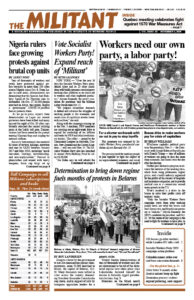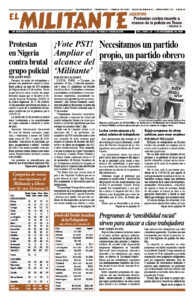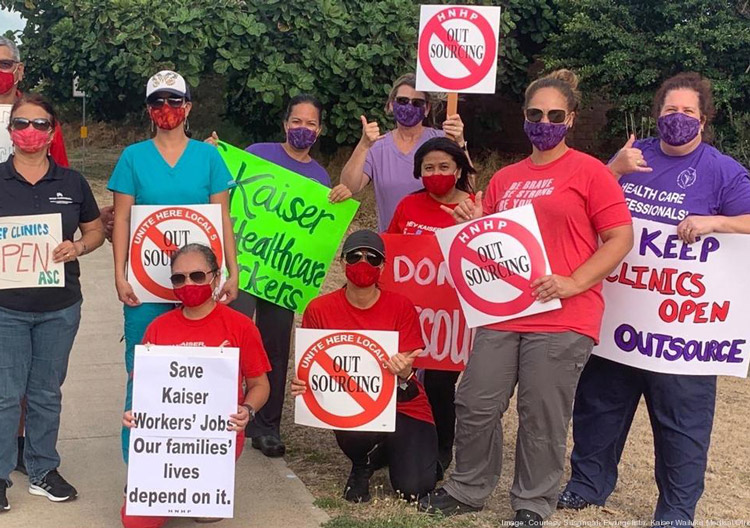Whichever capitalist political party wins the presidency Nov. 3 — the Democrats with Joseph Biden or Republicans with Donald Trump — tens of millions of workers are going to face the same deep economic, and moral crisis the day after the election.
Neither puts forward a program to advance the interests of the working class, which faces rising joblessness, higher prices, and a health industry organized for the profits of the owners of hospitals and insurance companies, not to provide medical care as a coronavirus second wave spreads in the U.S.
What’s involved is a drive by the bosses to solve their profits crisis off workers’ backs.
“Only the Socialist Workers Party campaign starts from what working people need, not what the bosses and their Democratic and Republican parties say is ‘realistic,’” Alyson Kennedy, the SWP’s candidate for president, said Oct. 20. “At the center of our campaign is the need to fight for workers to have jobs, to be part of the active working class and its struggles.”
On Oct. 13, Maersk, the largest container ship and supply-vessel operator in the world, said it’s eliminating at least 2,000 jobs. They join growing layoffs enforced by an array of company bosses, including those at United and American airlines; Royal Dutch Shell, BP and Chevron oil companies; AT&T’s WarnerMedia; Walt Disney theme parks; and many more. Auto production has fallen 8.3% over the past two months.
Rather than hiring more workers, bosses are pushing those on the job to work more hours, in more dangerous conditions, to maximize profits.
The number of people filing first time state unemployment claims rose to a two-month high of 898,000 a week as of Oct. 10. Together with federal programs set up to help self-employed, gig and other workers not eligible for regular unemployment, a total of 25.3 million people were claiming benefits as of Sept. 26.
And this doesn’t include millions more who haven’t been able to navigate the red tape to file or aren’t eligible because they’re immigrant workers without papers, or who work part time.
Long-term unemployed
Some 3.8 million people permanently lost their jobs in September. Yet during the three weeks ending Oct. 3, some 2.7 million people were cut off from state unemployment benefits, most because they’ve been out of work for over six months.
The employment-to-population ratio, which measures the number of people employed against the total working-age population, most accurately shows the depth of the jobless crisis. It was 61.1% in February, but just 56.6% in September.
The $600 weekly federal unemployment benefit that lasted until the end of July helped many workers put food on the table for several months. But once it ended many of these workers found themselves in dire straits, and the average checking account balance in the U.S. plummeted by 74%.
Lateisha Willett, of Davenport, Iowa, was let go in mid-March from the call center where she worked. After the $600 a week federal payment ended, she was left with only a weekly state benefit of $90, and $3 more for her 2-year-old son. She unsuccessfully applied for 30 jobs. “I’m afraid I’ll be evicted,” she told the Wall Street Journal. “And that will open another door to hell and chaos for me.”
It took until Sept. 1 for the federal government to order a suspension of evictions, but even then it allows landlords to begin the process during the moratorium, so workers will be on the streets more quickly when the moratorium ends in January. By then an estimated 8 million tenants may face eviction.
Rising energy, medical costs
Overwhelmed by surging demand for food, some food banks in New York City have imposed an appointment-only setup, with scheduling to be made through a computer app. If you don’t have a computer, or an internet connection, you’re out of luck. Computers thousands of workers depended on in public libraries are not available. Those without appointments now wait outside to beg for donations from those leaving the pantry with their carts full.
Natural gas prices are expected to rise 6% and electricity by 7% according to the National Energy Assistance Directors Association. Family health insurance premiums for lower paid workers have nearly quadrupled to $20,576 per year over the past two decades.
Having an insurance policy is no guarantee working people receive treatment. Several large Southern California hospital systems turned away or delayed treatment to critically sick COVID-19 patients when officials prioritized confirming whether hospital owners would get payments from the patients’ insurers.
Social Security administrators announced Oct. 13 that benefits for next year will rise just 1.3%, a measly $19 average monthly increase. “Social Security recipients have lost about 20% of their buying power since 2009,” Mary Johnson from the Senior Citizens League told Marketwatch.
As winter approaches moratoriums blocking utility cutoffs expired Oct. 14 in 18 states, and end in 18 others Dec. 31.


